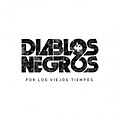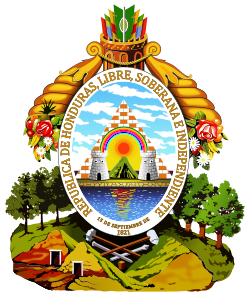Portal:Honduras
The Honduras Portal
Republic of Honduras República de Honduras (Spanish) | |
|---|---|
Motto:
| |
| ISO 3166 code | HN |
Honduras, officially the Republic of Honduras, is a country in Central America. It is bordered to the west by Guatemala, to the southwest by El Salvador, to the southeast by Nicaragua, to the south by the Pacific Ocean at the Gulf of Fonseca, and to the north by the Gulf of Honduras, a large inlet of the Caribbean Sea. Its capital and largest city is Tegucigalpa.
Honduras was home to several important Mesoamerican cultures, most notably the Maya, before Spanish colonization in the sixteenth century. The Spanish introduced Catholicism and the now predominant Spanish language, along with numerous customs that have blended with the indigenous culture. Honduras became independent in 1821 and has since been a republic, although it has consistently endured much social strife and political instability, and remains one of the poorest countries in the Western Hemisphere. In 1960, the northern part of what was the Mosquito Coast was transferred from Nicaragua to Honduras by the International Court of Justice.
The nation's economy is primarily agricultural, making it especially vulnerable to natural disasters such as Hurricane Mitch in 1998. Honduras has a Human Development Index of 0.624, ranking 138th in the world. In 2022, according to the National Institute of Statistics of Honduras (INE), 73% of the country's population lived in poverty and 53% lived in extreme poverty. The lower class is primarily agriculturally based while wealth is concentrated in the country's urban centers. The country is one of the most economically unequal in Latin America. (Full article...)
Selected article -
Augusto Monterroso Bonilla (December 21, 1921 – February 8, 2003) was a Honduran writer who adopted Guatemalan nationality, known for the ironical and humorous style of his short stories. He is considered an important figure in the Latin American "Boom" generation, and received several awards, including the Prince of Asturias Award in Literature (2000), Miguel Ángel Asturias National Prize in Literature (1997), and Juan Rulfo Award (1996). Monterroso was a member of the Honduran Academy of Language. (Full article...)
Interesting facts -
- ... that a river in Honduras swelled 15 meters (50 feet) above its normal level during torrential rains from a hurricane in 1935?
- ... that Honduran journalist Herlyn Espinal had aspirations of running for mayor of his hometown of Santa Rita, Yoro, before his murder?
- ... that William Chong Wong, the son of Chinese immigrant parents, twice served as Minister of Finance in Honduras?
- ... that the first woman to notoriously wear lipstick in Honduras is said to now be their premier woman poet?
Related portals
General images -
List articles

- Departments of Honduras
- List of cathedrals in Honduras
- List of companies of Honduras
- List of ecoregions in Honduras
- List of football clubs in Honduras
- List of Honduran departments by Human Development Index
- List of Hondurans
- List of Honduras-related topics
- List of national parks of Honduras
- List of political parties in Honduras
- List of presidents of Honduras
- List of rivers of Honduras
- List of wars involving Honduras
- Municipalities of Honduras
- Outline of Honduras
- Timeline of Tegucigalpa
Largest cities or towns
Topics
Map
Get involved
See WikiProject Honduras for editor resources and to collaborate with other editors on improving Wikipedia's Honduras-related articles.
Need help?
Do you have a question about Honduras that you can't find the answer to? Consider asking it at the Wikipedia reference desk.
Tasks
Did you know...
No recent additions
Associated Wikimedia
The following Wikimedia Foundation sister projects provide more on this subject:
-
Commons
Free media repository -
Wikibooks
Free textbooks and manuals -
Wikidata
Free knowledge base -
Wikinews
Free-content news -
Wikiquote
Collection of quotations -
Wikisource
Free-content library -
Wikiversity
Free learning tools -
Wikivoyage
Free travel guide -
Wiktionary
Dictionary and thesaurus
Sources
External media








































































































